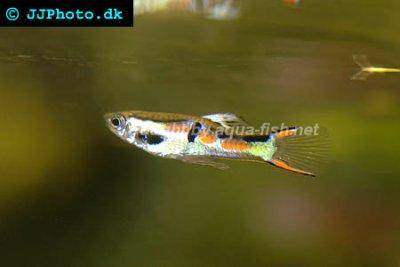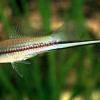Endler’s guppy - Poecilia wingei
Scientific name: Poecilia wingei
Common name: Endler’s guppy
Family: Poeciliidae
Usual size in fish tanks: 2 - 3 cm (0.79 - 1.18 inch)
014
Recommended pH range: 6.7 - 7.6
Recommended water hardness: 4 - 17°N (71.43 - 303.57ppm)
0°C 32°F30°C 86°F
Recommended temperature range: 22 - 26 °C (71.6 - 78.8°F)
The way how these fish reproduce: Pseudo-Livebearer
Where the species comes from: South America
Temperament to its own species: peaceful
Temperament toward other fish species: peaceful
Usual place in the tank: Top levels
Origin
Endler’s guppies, scientifically known as Poecilia wingei, are native to South America and can be found in the Paria Peninsula of Venezuela. They inhabit freshwater environments with vegetation and calm waters.
Lifespan
The expected lifespan for Poecilia wingei is between 3 to 5 years when kept in optimal conditions. Good water quality, proper diet, and a stress-free environment contribute to a longer, healthier life.
General Care
Endler’s guppies thrive best in small groups. Although they are small in size, they are quite active swimmers, requiring at least a 20-gallon (75 liters) tank for ample swimming space. Providing plants, both rooted and floating, offers hiding places and creates the dim lighting conditions they prefer. They are peaceful fish and are well-suited for community tanks with similarly sized, non-aggressive species. However, avoid placing them with larger or predatory fish that might view them as prey.
Females can be more territorial than males, particularly during spawning, and might show aggression toward each other. It is advisable to keep a higher ratio of females to males, such as 2-3 females per male, to prevent any one female from being bullied. Endler’s guppies are adaptable to a wide range of water parameters, but they do best in harder, alkaline water with a pH of 6.7 - 7.6.
Food and Feeding
Endler’s guppies are omnivorous and not picky eaters. A staple diet of algae-based flakes or small pellets is suitable for them, supplemented with occasional treats such as bloodworms, brine shrimp, and tubifex worms. Feeding small amounts twice a day is recommended, ensuring all food is consumed within a couple of minutes to prevent overfeeding and maintain water quality.
Sexing
Males are more colorful than females and often display elongated tail fins. Mature females are larger, have a fuller body, and possess a gravid spot near their anal fin, indicating their readiness for breeding. Females also tend to be gravid regularly, which is noticeable by their rounded bellies.
Breeding
Breeding Endler’s guppies is easy as they reproduce prolifically, much like their close relatives, the common guppies. Female Poecilia wingei give birth to live fry every 23 days, and these juveniles can be fed newly hatched brine shrimp or crushed flake food. It takes about 3-4 weeks for the fry to start developing their coloration. While females may eat their young if stressed, the frequent breeding means that the population will usually grow steadily. For hobby breeders aiming for maximum fry survival, it is best to move gravid females to a separate breeding tank before they give birth.
Tank Mates
Endler’s guppies are peaceful and do well in a community tank with other small, non-aggressive fish. Suitable tankmates include Ember Tetras, Harlequin Rasboras, Dwarf Corydoras, Neon Tetras, and other peaceful livebearers like Guppies. It is important to avoid large or predatory fish that might see them as food. A ratio of 2-3 females to each male helps maintain harmony and prevents males from constantly chasing females.
Short Description
Endler’s guppies are small, colorful fish that are easy to care for and make a lively addition to a peaceful community tank. Their small size, active nature, and stunning colors make them highly attractive to aquarists. Due to their jumping ability, always use a tight-fitting lid on the aquarium. While they can be kept in community tanks with suitable tankmates, they do particularly well in a species-only tank. Maintaining a group with a higher number of females than males will keep social dynamics peaceful.
Pictures
Bought by aqua-fish.net from jjphoto.dk.



 Pike
Pike  Biskop-tandkarpe
Biskop-tandkarpe  Mosquito
Mosquito  Twospot
Twospot  South
South  Sailfin
Sailfin  Guppy
Guppy  Short
Short  Swordtail
Swordtail  Platy
Platy  Variegated
Variegated